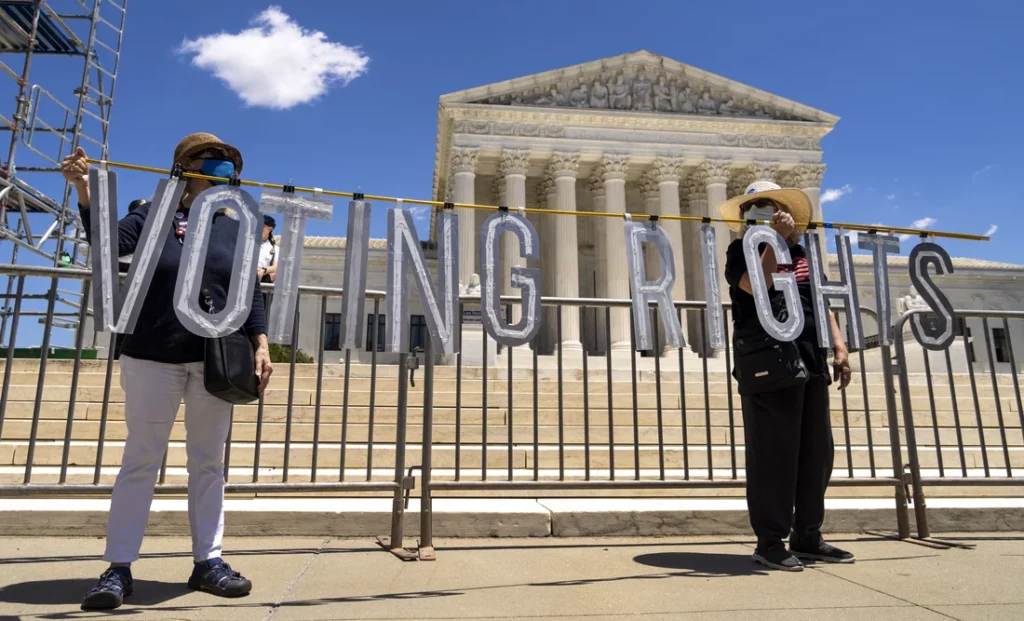
The U.S. Supreme Court’s upcoming decision on voting rights has the nation’s attention as it addresses a Pennsylvania case involving provisional ballots, particularly those with minor errors on mail-in ballots. The outcome of this high-stakes case could significantly impact voting accessibility across the country, especially as the 2024 election season draws near.
Background: The Pennsylvania Case on Provisional Ballots
At the heart of this case is a Pennsylvania law that allows for provisional ballots but requires them to meet strict criteria. If a voter’s mail-in ballot has any minor error, such as a missing date or incorrect information, it can be disqualified. Proponents argue that this standard helps prevent election fraud by ensuring every vote meets a set of strict guidelines, while opponents believe these restrictions unfairly burden voters by denying them their right to participate in the democratic process over minor mistakes.
The Pennsylvania Supreme Court ruled in favor of allowing ballots with minor mistakes to count, citing the intent behind each vote. However, this ruling has been met with legal challenges from groups who argue that leniency in voting standards could compromise election integrity. Now, the U.S. Supreme Court is set to review the case, and its decision could have far-reaching consequences for states’ authority over provisional ballot requirements.
How the Supreme Court’s Voting Rights Decision Could Impact Elections
The Supreme Court’s decision on voting rights will likely shape the way mail-in and provisional ballots are handled across the nation. With the rise in mail-in voting due to convenience and pandemic-driven measures, ballots with minor errors have become a significant issue, as slight oversights can disqualify otherwise valid votes. The case touches on fundamental questions of voting accessibility, with the court’s decision poised to either uphold or alter state-level rules.
Potential Outcomes and Their Implications
If the Supreme Court upholds Pennsylvania’s leniency on ballot errors, it could set a precedent that would allow other states to adopt similar practices. This change might encourage higher voter participation, especially among those who struggle with mail-in procedures. Conversely, if the Supreme Court sides with a more restrictive approach, many voters could face disenfranchisement, potentially leading to lower voter turnout, especially among marginalized groups who are statistically more likely to encounter procedural voting issues.
Voting Rights Advocates Argue for Accessibility
Voting rights advocates are closely watching the Supreme Court’s stance, hoping for a ruling that supports accessible voting practices. Many activists argue that penalizing voters for minor errors on mail-in ballots effectively suppresses votes and imposes an undue burden on certain demographics, including elderly, disabled, and low-income voters. They emphasize that the democratic process should prioritize voter inclusion and that disqualifying ballots over minor errors could disproportionately affect those with limited access to voting resources.
For voting rights groups, the core issue is about fair representation. They assert that, in a functioning democracy, every eligible vote should count, provided that the intent of the voter is clear. These groups are urging the court to consider how rigid ballot restrictions may exclude eligible voters over technicalities, undermining the very foundation of democratic participation.
Opposing Perspectives: Protecting Election Integrity
On the other side of the debate, those advocating for stricter rules argue that safeguarding election integrity is essential for public trust in the democratic process. They contend that any leniency in ballot requirements could increase the risk of fraud or manipulation, even if unintentionally. To this group, each election must uphold strict standards that ensure the authenticity and accuracy of every vote cast, even if that means excluding ballots that do not meet formal criteria.
Supporters of strict ballot regulations argue that procedural precision prevents the potential for double-voting or vote tampering, especially when dealing with absentee and mail-in ballots. They believe that making exceptions for minor errors on ballots could create a slippery slope, ultimately compromising the reliability of elections. This perspective, while controversial, speaks to a longstanding concern over election security, particularly in an era of increased political division.
The Legal Precedent: Past Supreme Court Rulings on Voting Rights
The U.S. Supreme Court has ruled on several notable voting rights cases in recent years, with mixed outcomes that reflect the ongoing tension between accessibility and security in elections. In Shelby County v. Holder (2013), for example, the court significantly weakened the Voting Rights Act by removing the requirement for states with histories of voter discrimination to obtain federal clearance before changing voting laws. This decision has led to an increase in state-level voting restrictions, as states are no longer subject to federal oversight on voting policies.
More recently, the court ruled in Brnovich v. Democratic National Committee (2021) in favor of Arizona’s restrictive voting policies, further complicating the landscape for voting rights. This ruling granted states greater leeway in establishing voting requirements, highlighting the court’s inclination toward supporting state sovereignty in election laws. The upcoming Pennsylvania case marks the latest chapter in this ongoing legal struggle, with the potential to either reinforce or counter recent trends.
What’s at Stake for Future Elections
The implications of this case go beyond Pennsylvania, as the Supreme Court’s decision could influence state voting laws nationwide. A ruling in favor of leniency on provisional ballots could help voters across the country feel more secure in participating, knowing that minor technical errors won’t invalidate their votes. For those advocating for greater accessibility, this case represents an opportunity to establish legal protections that safeguard voters from disenfranchisement.
However, if the ruling favors strict requirements, states may adopt more restrictive policies, which could dissuade voters from participating in future elections. Such an outcome could deepen existing inequalities in the electoral system, where barriers to voting often affect certain populations disproportionately. With national elections on the horizon, the impact of this case could play a pivotal role in shaping voter turnout and election outcomes.
Conclusion: The Supreme Court’s Role in Shaping Voting Rights
As the U.S. Supreme Court prepares to weigh in on the Pennsylvania case, the country waits to see how this decision will impact voting rights and accessibility across the nation. This case underscores the delicate balance between protecting election integrity and ensuring voter inclusion, a balance that has become increasingly polarized.
Whether the court chooses to favor stricter regulations or greater leniency, its decision will undoubtedly have far-reaching consequences for America’s electoral process, setting the stage for a debate that could define the future of U.S. voting rights. For voters, activists, and policymakers alike, the Supreme Court’s stance will reveal much about the direction of American democracy and the value placed on each individual’s right to vote.
image credit – Drew Angerer/Getty Images


